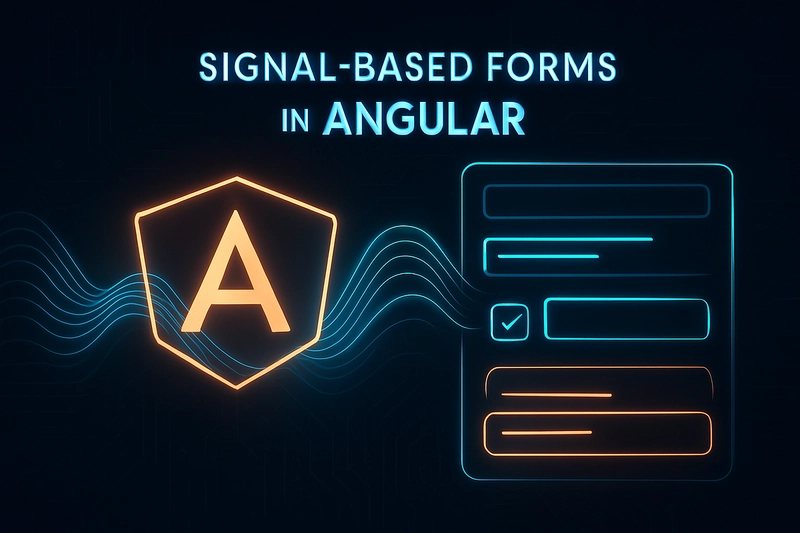What if the next generation of Angular forms could be simpler, more reactive, and more powerful? Signal-based forms bring a transformative approach to how developers manage reactive forms in Angular, addressing common pain points with increased clarity and efficiency. Unlike traditional reactive forms, signals introduce a new level of automatic reactivity by leveraging Angular’s reactive signal system, simplifying state management and change detection. This article will dive deep into what signals are, how integrating them into forms can revolutionize form handling, and practical techniques for implementing signal-based forms in your Angular applications. By the end, readers will understand why signal-based forms are poised to enhance both developer experience and application performance.
Note: Signal-based forms are an upcoming feature and are not officially released yet. In this article, the implementation demonstrated aims to mimic the future feature using current Angular tools and techniques that are available today.
Understanding Signals in Angular Forms
Signals are a new way to manage reactive state in Angular forms, making form reactivity simpler and more efficient. This chapter explains what signals are, how they differ from traditional methods, and why Angular introduced them to improve form handling.
Signal Fundamentals
Signals encapsulate state and automatically notify when state changes, eliminating the need for manual subscriptions. They offer a declarative and straightforward way to manage reactive data, reducing complexity and improving readability.
- Key Takeaway 1: Signals provide automatic, declarative reactive state tracking.
- Key Takeaway 2: They simplify code by combining state and change notification.
Angular’s Reactive Forms Overview
Angular’s reactive forms use FormControls and observables to manage form state and validation but often involve verbose subscription handling. Signals enhance this by providing a cleaner and more direct way to bind and react to form state changes.
🚀 Ready to level up your frontend game? Download my 10-Step Frontend Code Review Checklist now and start shipping cleaner, faster, and more secure web apps today! 📋✨ DOWNLOAD NOW!
- Key Takeaway 1: Reactive forms manage state with FormControl and observables.
- Key Takeaway 2: Signals reduce boilerplate in tracking form state changes.
Why Signals Matter in Angular Forms
Signals help create more efficient, maintainable forms by automatically handling state updates and dependencies. They improve performance and reduce bugs by eliminating manual subscription management.
- Key Takeaway 1: Signals simplify reactive form state management.
- Key Takeaway 2: They boost performance and reduce error-prone code.
Code Example: Signals in Action
This example shows a signal tracking an input field’s value reactively, updating the UI without manual subscriptions.
Signals bring a cleaner, reactive approach to Angular forms, making form state easier to handle with better performance and simpler code.
Angular signals offer a fresh way to create reactive forms with less boilerplate and more intuitive state management. This chapter introduces how signals can simplify form creation, validation, and dynamic behavior.
Building Forms with Signals
Angular signals offer a fresh way to create reactive forms with less boilerplate and more intuitive state management. This chapter introduces how signals can simplify form creation, validation, and dynamic behavior.
Creating Form Fields with Signals
Signals represent each form field’s state reactively, automatically reflecting user input. This approach reduces the need for manual synchronization found in traditional form controls.
- Key Takeaway 1: Signals provide a simple, reactive way to manage individual form fields.
- Key Takeaway 2: Form fields tied to signals update seamlessly with user actions.
Computed Signals for Form State and Validation
Computed signals combine multiple field signals to derive the overall form state, such as validity. This makes validation reactive and easier to maintain.
- Key Takeaway 1: Computed signals simplify reactive form validation logic.
- Key Takeaway 2: Form state updates automatically based on field inputs.
Dynamic Form Control with Signals
Signals support dynamic form behaviors, like adding or removing fields based on user choices, updating the form state instantly.
- Key Takeaway 1: Signals enable easy dynamic control of form fields.
- Key Takeaway 2: The form adjusts reactively to structural changes without extra code.
Using signals in Angular transforms form building into a reactive, straightforward process with clear, maintainable code and improved user experience.
Advantages of Signal-Based Forms Over Traditional Forms
Signal-based forms offer a modern, efficient way to manage forms in Angular, improving reactivity and developer productivity. This chapter highlights their benefits over template-driven and reactive forms.
Improved Reactivity
Signal-based forms automatically update the UI when form values change, minimizing overhead compared to reactive forms that use RxJS. This leads to faster, more responsive applications.
- Key Takeaway 1: Instant, automatic UI updates with minimal performance cost.
- Key Takeaway 2: Reduced unnecessary change detection and re-renders.
Declarative State Management
Form state is handled declaratively using signals, making code simpler and easier to understand than the more verbose reactive form APIs.
- Key Takeaway 1: Less boilerplate, clearer state representation.
- Key Takeaway 2: Predictable and maintainable form state changes.
Granular Control and Flexibility
Signal-based forms give precise control over each form field, making them ideal for dynamic forms that change based on user input or data. This flexibility surpasses traditional forms’ capabilities.
- Key Takeaway 1: Easy handling of complex, dynamic form scenarios.
- Key Takeaway 2: Smooth implementation of conditional form logic.
Code Comparison
Reactive form:
this.form = this.fb.group({
name: ['', Validators.required],
age: [null, Validators.min(18)],
});
this.form.valueChanges.subscribe(value => console.log(value));
Signal-based form:
const name = signal('');
const age = signal(null);
const isValid = computed(() => name().length > 0 && (age() ?? 0) >= 18);
effect(() => console.log({ name: name(), age: age() }));
Signals simplify code by removing manual subscriptions and enabling direct reactive updates.
Signal-based forms provide a cleaner, more efficient approach to Angular form management with improved reactivity, simplicity, and flexibility over traditional forms.
Advanced Use Cases and Best Practices with Angular Signals in Forms
This chapter dives into using Angular signals for complex form scenarios, including nested forms, dynamic fields, and validation integration, to create efficient and maintainable forms.
👉 SUBSCRIBE NOW & Get Your FREE 10-Step Frontend Code Review Checklist!
Handling Complex Nested Forms
Signals help manage nested form controls separately while keeping their states reactive and modular. This reduces unnecessary updates and improves performance, especially for complex form sections like addresses within a user profile.
- Key Takeaway 1: Signals enable modular, reusable nested form controls.
- Key Takeaway 2: They optimize performance by minimizing re-renders.
Integrating Signals with Angular Validation
Signals make validation status reactive and simple to manage. They automatically update as users interact with fields, combining seamlessly with Angular’s built-in and custom validators.
- Key Takeaway 1: Signals provide instant validation state feedback.
- Key Takeaway 2: They reduce boilerplate around error handling.
Managing Dynamic Form Fields
Dynamic forms benefit from signals by easily adding or removing controls based on user input or data changes. Signals keep validations consistent even as form structure changes.
- Key Takeaway 1: Signals simplify reactive management of dynamic controls.
- Key Takeaway 2: Validation stays accurate amid field changes.
Using signals in advanced form scenarios improves clarity, responsiveness, and maintainability, empowering developers to handle complex forms with confidence.
Conclusion
Signal-based forms in Angular offer a powerful, elegant way to build reactive forms with greater clarity and efficiency. By reducing boilerplate and enabling fine-grained reactivity, signals simplify form management and improve performance. This modern approach is shaping the future of Angular form development, making it easier for developers to create responsive, maintainable user interfaces.
Call to Action
Explore signal-based forms in your next projects to experience their benefits firsthand. Experiment with integrating signals into existing forms and stay updated with Angular’s latest features to keep your skills relevant and sharp.
Thanks for Reading 🙌
I hope these tips help you ship better, faster, and more maintainable frontend projects.
💬 Let’s Connect on LinkedIn
I share actionable insights on Angular & modern frontend development - plus behind‑the‑scenes tips from real‑world projects.
👉 Connect with me here
🛠 Explore My Developer Resources
Save time and level up your code reviews, architecture, and performance optimization with my premium Angular & frontend tools.
👉 Browse on Gumroad
Your support fuels more guides, checklists, and tools for the frontend community.
Let’s keep building together 🚀




